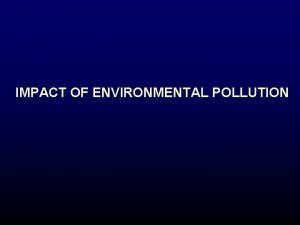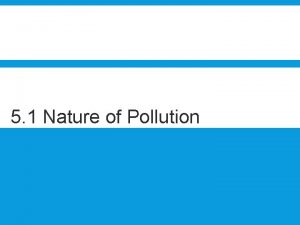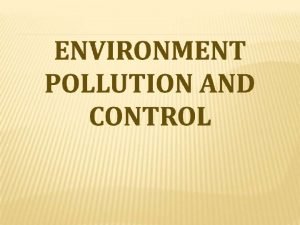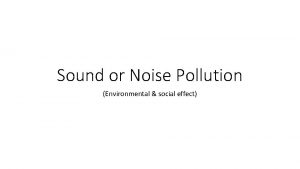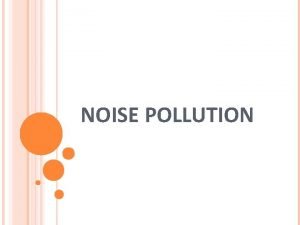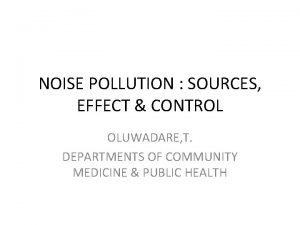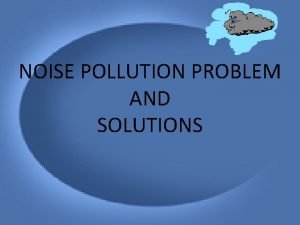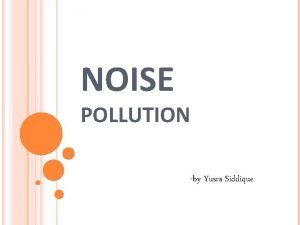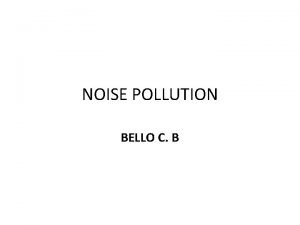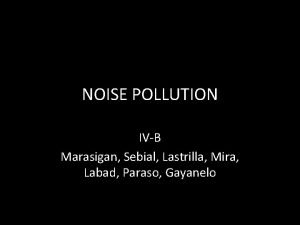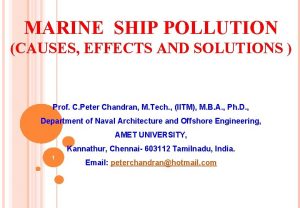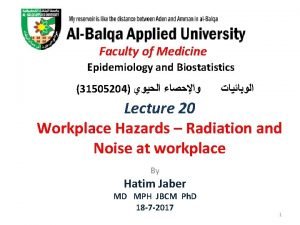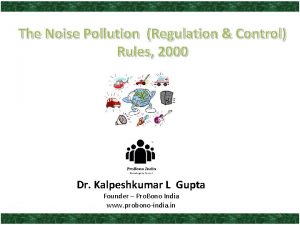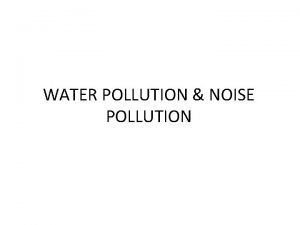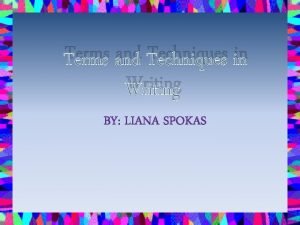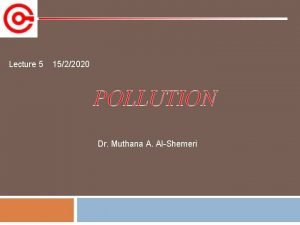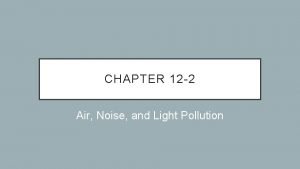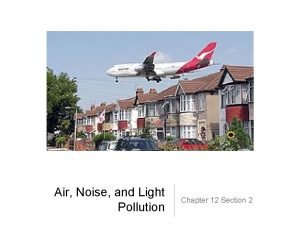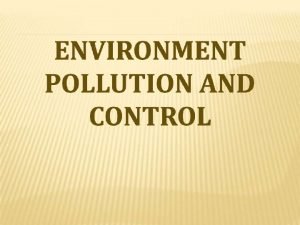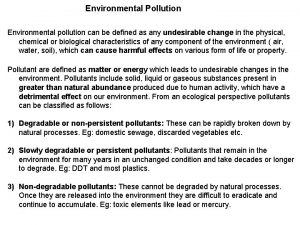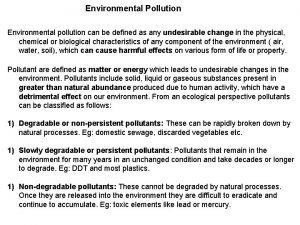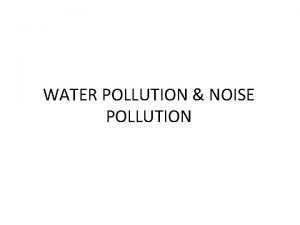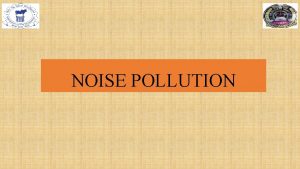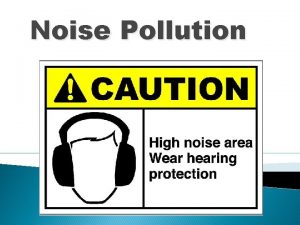ENVIRONMENTAL ENGINEERING NOISE POLLUTION Definition Noise is defined



















- Slides: 19

ENVIRONMENTAL ENGINEERING NOISE POLLUTION

Definition • Noise is defined as unwanted signal. • To be more specific, noise is referring to unwanted sound. • But, sometimes the word “unwanted” can be subjective. • Two type of noise pollutions: a) Voluntary noise b) Involuntary noise

Classification of Sound • Continuous -An uninterrupted sound level that varies less than 5 d. B during the period of observation. -Example: Noise from household fan • Intermittent -A continuous sound that last for more than one second but then interrupted for more than one second. - Example: A dentist’s drilling • Impulsive/Impact -A sound which last for less than one second. -Example: Noise from firing a weapon

Effect of Noise • Reduction of quality of life; i. e. interfere speech, conversation and sleep. • Physiological effects, i. e. hearing effects. • Psychological effects, i. e learning effect, mental health

Source of Noise can be emitted from: • A point source – electric fan • A line source – moving train

Source of Noise pollution comes from: • Traffic • Industrial equipment • Construction activities • Sporting & crowding activities • Low-flying aircraft.

Noise Control The level of noise can be reduce by using one of three strategies 1 - protect the recipient 2 - Reduce Source of Noise

Noise Control 1 - protect the recipient Using ear plugs for ear protection is not effective for most of noise types. Thus , better to protect the entire ear and protect the ear plugs wearer from the most noise

Noise Control 2 - Reduce Source of Noise The most effective means of noise control is source reduction. Re-design of commercial airplanes has already been mention as an example of noise source reduction.

Noise Control For traffic noise Reduction can be achieved via re-designing vehicles and pavements. Increasing transportation the use of alternative Reducing vehicle speed and encouraging to use alternative routes, through speed control devices or road designs

Sound Power • Sound power (W): the rate at which energy is transmitted by sound wave. • Sound Intensity (I): Average sound power per unit area normal to propagation of a sound. W = ∫A I d. A …. . (1)

Sound Power • In an environment, in which there are no reflecting surface, the r. m. s. sound pressure, Prms at any point is related to I by following equation: I = P 2 rms / ρc …. . (2)

The Decibel • Human ear able hear enormous range of sound pressure. (20 μPa to 1013 for normal people). • Therefore, sound pressure of linear scale is an inconvenient quantity to use. • This also applied to sound power and sound intensity.

Sound Pressure Level, Lp Sound pressure level, Lp is defined as Lp = log 10 (P 2 rms/ P 2 ref) Unit : Bel …. . (3) Or, Lp = 10 log 10 (P 2 rms/ P 2 ref) Unit : (d. B) …. . (4) Pref = 20 μPa. The factor 10 is introduced in above equation as to avoid a scale that is to compressed.

Sound Power Level, Lw Sound power level, Lw is defined as: Lw = 10 log 10 (W/ Wref) where; Wref = 10 -12 Watt Unit : (d. B) …. . (5)

Sound Intensity Level, LI is given by: LI = 10 log 10 ( I/ Iref) where; Iref = 10 -12 Watt/m 2 Unit : (d. B) …. . (6)

Example 3 -1 The sound pressure inside a diesel lorry is 2 Pa. What is corresponding SPL in d. B? (Answer: 100 d. B)

Example 3 -2 If a sound source has a pressure of 1500 Pa, compute: a) The SPL in d. B b) The sound intensity in Watt/m 2 Given; ρ = 1. 185 kg/m 3 , c = 340 m/s

Example 3 -3 What is the increase in d. B that corresponds to a five time increase of sound pressure?
 Paribhasha
Paribhasha Noise pollution definition
Noise pollution definition Definition environmental pollution
Definition environmental pollution What is a collection of well defined objects
What is a collection of well defined objects Conclusion of noise pollution
Conclusion of noise pollution Solutions for noise pollution
Solutions for noise pollution Introduction of noise pollution
Introduction of noise pollution Pollution means
Pollution means Effects of noise pollution on human health
Effects of noise pollution on human health Noise pollution introduction
Noise pollution introduction Control measures of noise pollution
Control measures of noise pollution Noise pollution control methods ppt
Noise pollution control methods ppt Pollution causes effects and solutions
Pollution causes effects and solutions Solution of noise pollution
Solution of noise pollution Noise pollution act
Noise pollution act Sources of noise pollution
Sources of noise pollution Poem on noise pollution
Poem on noise pollution Problems of noise pollution
Problems of noise pollution Air noise and light pollution
Air noise and light pollution Section 2 air noise and light pollution
Section 2 air noise and light pollution
